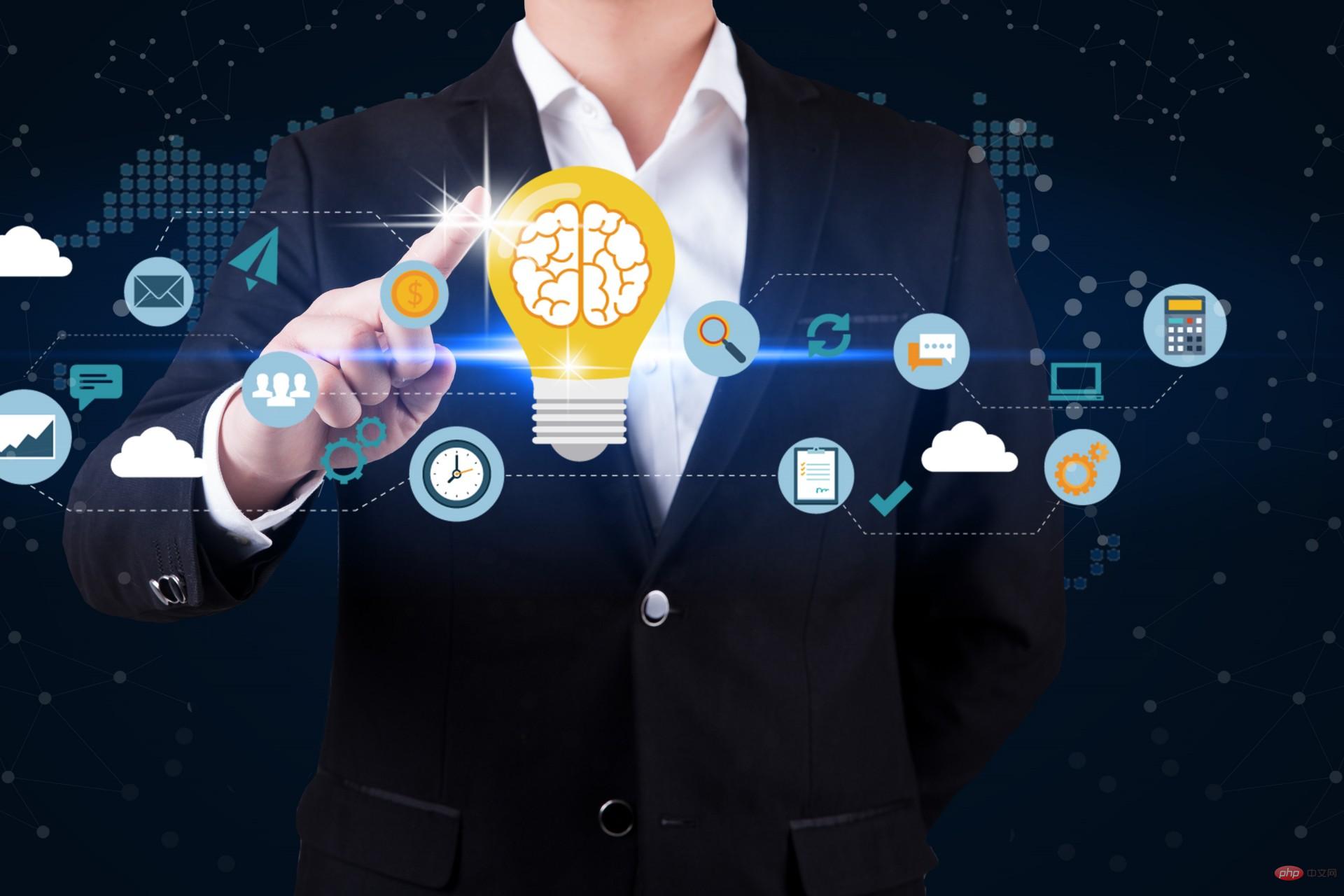 Technology peripherals
Technology peripherals AI
AI Academician Liu Jingnan discusses the relationship between natural intelligence and artificial intelligence
Academician Liu Jingnan discusses the relationship between natural intelligence and artificial intelligenceLiu Jingnan believes that can understand and define artificial intelligence from the perspective of natural intelligence and time and space.
Currently, information networks are evolving towards the Internet of Things and ubiquitous networks. It is driven by big data, more powerful computing capabilities and more intelligent computing methods, resulting in a new generation of artificial intelligence, that is, computers with the ability to learn and Thinking and other abilities. At the same time, in order to realize the intelligent management and collaborative control of the physical world by computer networks, the cyber-physical system CPS (also known as the ubiquitous network) came into being and was integrated with artificial intelligence to accelerate social production and consumption. From industrialization to automation and intelligence, mankind has entered the era of intelligence. Intelligence is the ability of living creatures in nature to perceive, recognize, and adapt to the environment. Living things have intelligence because they can perceive changes in the outside world and recognize the pros and cons of changes. , after making a decision, adjust itself to achieve advantages and avoid disadvantages. To achieve this goal, it is necessary to find the accurate place, time, orientation, posture, etc., to adjust itself. Therefore, the core of biological intelligence in nature is, Based on the precise time and space location of perceiving and recognizing changes in the external world, we can make choices and behaviors that seek advantages and avoid disadvantages.
Therefore, natural intelligence can be defined as the ability of living things to perceive changes in the outside world, learn and remember to form experiences, rise to cognition, make decisions to adapt to changes in the outside world and their own safety needs, and regulate themselves at the accurate time and place. Or partially change the state of the outside world to achieve the goal of seeking advantages and avoiding disadvantages. Intelligence can solve current problems, while wisdom can solve future and unknown problems. Wisdom requires experience and knowledge formed through perception and cognition. Reasoning, predicting changes in the external world at a certain time and place in the future, and performing self-regulation in advance to change the state of oneself or part of the external world in order to seek benefits and avoid harm. This kind of regulation is often based on precise time and space positions. , accurately coordinate multiple behaviors and actions to change the outside world. Therefore, the ability to position, navigate, and know the time is the innate survival ability of living things to achieve advantages and avoid disadvantages, which belongs to natural intelligence. In this sense, surveying and mapping is The process and means of perceiving, recording and expressing events that occur at a certain time and place, and then assisting cognition, communication and decision-making, are an extension of the technical methods of intelligent behaviors such as human positioning, navigation and timing. In summary, intelligence and wisdom are abilities that only exist in the biological world.
Artificial intelligence is to impart biological intelligence in nature (including human intelligence and wisdom) to machines and environments through technology and methods, so that machines and the environment can interact with each other. The environment can sense and recognize changes in the outside world, and manage and regulate accordingly to seek advantages and avoid disadvantages.Defining artificial intelligence on the basis of natural intelligence is more accurate and more universal than the current definition of artificial intelligence used by the computer industry such as the Turing test to "make machines perceive and think like humans". It reflects Natural intelligence includes the connotation of 6 types of intelligence such as perception, learning, cognition, decision-making, regulation and even emotion. Artificial intelligence should include at least 5 types of intelligence connotation in addition to emotion. In fact, perceptual intelligence and swarm intelligence in the animal kingdom are in many It far exceeds that of humans. Giving the perceptual intelligence and group intelligence of the animal kingdom to machines and the environment is a major research direction of artificial intelligence
.
 According to CSDN author’s definition:
According to CSDN author’s definition:
Natural Intelligence (NI) refers to people producing valuable behaviors through brain calculations and decision-making. These behaviors include human brain thinking and decision-making, ears hearing and judgment, eye vision and judgment, nose smell and judgment, skin touch and judgment, etc., and are reflected in all aspects of human behavior.
Artificial Intelligence (AI) uses machines to replace people and realize intelligent behaviors possessed by people. The sentence can be rewritten like this: It mainly refers to computers, data and related software, and can even cover related intelligent terminal equipment. At present, relatively mature technical directions for artificial intelligence applications include machine gaming (intelligent robots), voice recognition, image recognition (text, fingerprints, faces, etc.), and data analysis and prediction provided by sensors. The main disciplines of artificial intelligence research cover computer science, information theory, cybernetics, automation, bionics, biology, psychology, mathematical logic, linguistics, medicine and philosophy, etc.
Machine Learning (ML) is the scientific study of algorithms and statistical models, which are used by computer systems to effectively perform specific tasks without using explicit instructions, but relying on patterns and reasoning. It is considered a subset of artificial intelligence and is the core of artificial intelligence. Machine learning must "learn" with the help of data. Machine learning can be divided into supervised learning, semi-supervised learning, unsupervised learning and reinforcement learning according to the form.
Deep Learning (DL), (also known as deep structured learning or hierarchical learning) is part of a family of machine learning methods based on learning data representations, rather than task-specific algorithms. Deep learning is inspired by information processing and communication patterns in biological nervous systems, but differs from the structure and function of biological brains. Currently, deep learning architectures, such as deep neural networks, deep belief networks, and recurrent neural networks, have been used in computer vision, speech recognition, natural language processing, audio recognition, social network filtering, machine translation, bioinformatics, drug design, and medicine Image analysis and other fields.
(The above concepts and their relationships are original creations of CSDN blogger "Simple Little Bitter Melon", original link: https://blog.csdn.net/weixin_44482877/article/details/122273597)
The above article selection is a way for the author to explore silicon-based organisms and carbon-based life as a whole, or to explore the cognitive methodology of brain-computer interface, so as to understand bionics and brain neural networks.
The above is the detailed content of Academician Liu Jingnan discusses the relationship between natural intelligence and artificial intelligence. For more information, please follow other related articles on the PHP Chinese website!
 2023年机器学习的十大概念和技术Apr 04, 2023 pm 12:30 PM
2023年机器学习的十大概念和技术Apr 04, 2023 pm 12:30 PM机器学习是一个不断发展的学科,一直在创造新的想法和技术。本文罗列了2023年机器学习的十大概念和技术。 本文罗列了2023年机器学习的十大概念和技术。2023年机器学习的十大概念和技术是一个教计算机从数据中学习的过程,无需明确的编程。机器学习是一个不断发展的学科,一直在创造新的想法和技术。为了保持领先,数据科学家应该关注其中一些网站,以跟上最新的发展。这将有助于了解机器学习中的技术如何在实践中使用,并为自己的业务或工作领域中的可能应用提供想法。2023年机器学习的十大概念和技术:1. 深度神经网
 超参数优化比较之网格搜索、随机搜索和贝叶斯优化Apr 04, 2023 pm 12:05 PM
超参数优化比较之网格搜索、随机搜索和贝叶斯优化Apr 04, 2023 pm 12:05 PM本文将详细介绍用来提高机器学习效果的最常见的超参数优化方法。 译者 | 朱先忠审校 | 孙淑娟简介通常,在尝试改进机器学习模型时,人们首先想到的解决方案是添加更多的训练数据。额外的数据通常是有帮助(在某些情况下除外)的,但生成高质量的数据可能非常昂贵。通过使用现有数据获得最佳模型性能,超参数优化可以节省我们的时间和资源。顾名思义,超参数优化是为机器学习模型确定最佳超参数组合以满足优化函数(即,给定研究中的数据集,最大化模型的性能)的过程。换句话说,每个模型都会提供多个有关选项的调整“按钮
 人工智能自动获取知识和技能,实现自我完善的过程是什么Aug 24, 2022 am 11:57 AM
人工智能自动获取知识和技能,实现自我完善的过程是什么Aug 24, 2022 am 11:57 AM实现自我完善的过程是“机器学习”。机器学习是人工智能核心,是使计算机具有智能的根本途径;它使计算机能模拟人的学习行为,自动地通过学习来获取知识和技能,不断改善性能,实现自我完善。机器学习主要研究三方面问题:1、学习机理,人类获取知识、技能和抽象概念的天赋能力;2、学习方法,对生物学习机理进行简化的基础上,用计算的方法进行再现;3、学习系统,能够在一定程度上实现机器学习的系统。
 得益于OpenAI技术,微软必应的搜索流量超过谷歌Mar 31, 2023 pm 10:38 PM
得益于OpenAI技术,微软必应的搜索流量超过谷歌Mar 31, 2023 pm 10:38 PM截至3月20日的数据显示,自微软2月7日推出其人工智能版本以来,必应搜索引擎的页面访问量增加了15.8%,而Alphabet旗下的谷歌搜索引擎则下降了近1%。 3月23日消息,外媒报道称,分析公司Similarweb的数据显示,在整合了OpenAI的技术后,微软旗下的必应在页面访问量方面实现了更多的增长。截至3月20日的数据显示,自微软2月7日推出其人工智能版本以来,必应搜索引擎的页面访问量增加了15.8%,而Alphabet旗下的谷歌搜索引擎则下降了近1%。这些数据是微软在与谷歌争夺生
 荣耀的人工智能助手叫什么名字Sep 06, 2022 pm 03:31 PM
荣耀的人工智能助手叫什么名字Sep 06, 2022 pm 03:31 PM荣耀的人工智能助手叫“YOYO”,也即悠悠;YOYO除了能够实现语音操控等基本功能之外,还拥有智慧视觉、智慧识屏、情景智能、智慧搜索等功能,可以在系统设置页面中的智慧助手里进行相关的设置。
 人工智能在教育领域的应用主要有哪些Dec 14, 2020 pm 05:08 PM
人工智能在教育领域的应用主要有哪些Dec 14, 2020 pm 05:08 PM人工智能在教育领域的应用主要有个性化学习、虚拟导师、教育机器人和场景式教育。人工智能在教育领域的应用目前还处于早期探索阶段,但是潜力却是巨大的。
 30行Python代码就可以调用ChatGPT API总结论文的主要内容Apr 04, 2023 pm 12:05 PM
30行Python代码就可以调用ChatGPT API总结论文的主要内容Apr 04, 2023 pm 12:05 PM阅读论文可以说是我们的日常工作之一,论文的数量太多,我们如何快速阅读归纳呢?自从ChatGPT出现以后,有很多阅读论文的服务可以使用。其实使用ChatGPT API非常简单,我们只用30行python代码就可以在本地搭建一个自己的应用。 阅读论文可以说是我们的日常工作之一,论文的数量太多,我们如何快速阅读归纳呢?自从ChatGPT出现以后,有很多阅读论文的服务可以使用。其实使用ChatGPT API非常简单,我们只用30行python代码就可以在本地搭建一个自己的应用。使用 Python 和 C
 人工智能在生活中的应用有哪些Jul 20, 2022 pm 04:47 PM
人工智能在生活中的应用有哪些Jul 20, 2022 pm 04:47 PM人工智能在生活中的应用有:1、虚拟个人助理,使用者可通过声控、文字输入的方式,来完成一些日常生活的小事;2、语音评测,利用云计算技术,将自动口语评测服务放在云端,并开放API接口供客户远程使用;3、无人汽车,主要依靠车内的以计算机系统为主的智能驾驶仪来实现无人驾驶的目标;4、天气预测,通过手机GPRS系统,定位到用户所处的位置,在利用算法,对覆盖全国的雷达图进行数据分析并预测。


Hot AI Tools

Undresser.AI Undress
AI-powered app for creating realistic nude photos

AI Clothes Remover
Online AI tool for removing clothes from photos.

Undress AI Tool
Undress images for free

Clothoff.io
AI clothes remover

AI Hentai Generator
Generate AI Hentai for free.

Hot Article

Hot Tools

Dreamweaver Mac version
Visual web development tools

SublimeText3 Chinese version
Chinese version, very easy to use

SAP NetWeaver Server Adapter for Eclipse
Integrate Eclipse with SAP NetWeaver application server.

Safe Exam Browser
Safe Exam Browser is a secure browser environment for taking online exams securely. This software turns any computer into a secure workstation. It controls access to any utility and prevents students from using unauthorized resources.

VSCode Windows 64-bit Download
A free and powerful IDE editor launched by Microsoft





